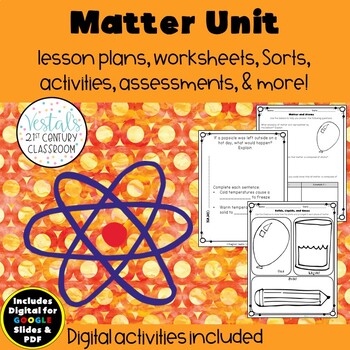Matter Unit - Lesson Plans & Activities - {Digital & PDF Included}
- Zip
Also included in
- With this 5th Grade Science Bundle, you get EVERY SOL-aligned lesson and activity needed to teach 5th-grade science for an ENTIRE YEAR! What’s included in this science bundle? This 5th Grade Science Bundle includes 9 science units. Each unit is STEM-based and incorporates LOTS of critical thinking aPrice $104.50Original Price $118.50Save $14.00
Description
Are you looking for engaging lesson plans and activities that have to do with matter? Look no further! This Matter Unit provides everything you need! Save time planning and your students will love completing the hands-on activities.
To take a closer look at some of the activities included in this unit, check out the preview!
What will students investigate through these detailed lesson plans?
- How to define matter
- The three phases of matter (solids, liquids, and gases) and their characteristics
- Physical and chemical changes
- The effects of temperature on matter
- Mixtures and solutions
- How to separate two different types of matter within a mixture
This Matter Unit also comes with three bonus lessons about the structure of an atom, elements, molecules, and compounds. The information from these lessons is not included on the assessments found in this unit, but these lessons provide some additional hands-on activities that can be used to reinforce the concepts listed above.
What comes in this Matter Unit?
- Worksheets
- Centers
- Entry/exit tickets
- Sorts
- Flip Book
- Quiz
- Test
- Lots of engaging, hands-on activities and experiments
- 2 Sets of Word Wall Cards: One set of word wall cards with pictures and another set with only the term on each card.
- 1 Timeline of Suggested Activities: Provides a timeline for using the activities and experiments included within this set and provides links to websites featuring videos of concepts being taught.
- Answer keys
What are key terms used throughout the unit?
- Matter
- Mass
- Volume
- Mixture
- Solution
- Physical Change
- Chemical Change
- Atom
Are digital resources included?
Some worksheets, the quiz, and the test within this Matter Unit are also included in a digital format and can be shared with students using your Google Drive.
When you purchase this product, you will be given access to a link that will allow you to open the file in Google Slides. You’ll then share that file with your students. The slides can be printed and adapted for students who prefer to answer the questions by hand. You can also view and print a student's completed version of the slides.
What standards are covered?
This Matter Unit closely aligns with most science standards related to teaching matter, including NGSS (5-PS1-1, 5-PS1-3, 5-PS1-4). The unit is also aligned with both the 2010 and 2018 Virginia science SOLs. It is aligned with science SOL 5.4 if using the 2010 standards and science SOL 5.7 if using the 2018 standards.
What Other Buyers Are Saying:
“This is my second unit by this author. I find a great variety of activities and many hands on activities. It presents the key concepts in a way that's easy to understand. The quizzes and test are a great bonus!” (Donna W.)
“A really good in-depth product to boost student engagement.” (Treaundra S.)
“This was definitely one of the best things I've bought.” (Rachel B.)
“This is wonderful easy-to-use resource that incorporates higher level thinking! Thanks!!!” (Leslie T.)
Don’t Miss Out!
This Matter Unit is perfect if you are low on planning time or have no idea where to begin! Students will also have fun learning the information as they complete all of the activities!
Other Related Products that May Interest You:
5th Grade Science Task Card Bundle
--------------------------------------------------
Other Information:
Follow my TpT store to learn about the newest resources and freebies!
Feedback helps me create great products for you to use in your classroom. Please consider leaving detailed feedback about how this resource worked in your classroom. Each time you provide feedback, you earn TpT credits that can be redeemed for free and discounted resources on TpT in the future.
©Meghan Vestal, Vestal’s 21st Century Classroom LLC. All rights reserved. This product is to be used by the original downloader only. Copying for teachers, classroom, department, school, or school system is prohibited. This product may not be distributed or displayed digitally for public view. Teachers may NOT upload the product to school/district servers, or to any website, or share digital or print copies. Failure to comply is a copyright infringement and a violation of the Digital Millennium Copyright Act (DMCA).






